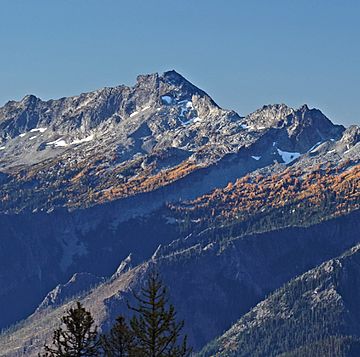Bandit Peak facts for kids
Quick facts for kids Bandit Peak |
|
|---|---|

Bandit Peak, north aspect, from Mount Maude
|
|
| Highest point | |
| Elevation | 7,625 ft (2,324 m) |
| Prominence | 1,305 ft (398 m) |
| Isolation | 5.44 mi (8.75 km) |
| Parent peak | Brahma Peak (8,078 ft) |
| Geography | |
| Location | Glacier Peak Wilderness Chelan County, Washington, U.S. |
| Parent range | North Cascades Cascade Range |
| Topo map | USGS Schaefer Lake |
| Climbing | |
| Easiest route | class 4 |
Bandit Peak is a cool mountain in Washington. It stands 7,625-foot (2,324-metre) tall. This mountain has two main tops, like a double peak! It's made of a type of rock called granite.
You can find Bandit Peak in the Glacier Peak Wilderness. This is a wild area within the North Cascades mountains. It's located in Chelan County, Washington, in the U.S.. The mountain is managed by the Okanogan-Wenatchee National Forest.
Bandit Peak is east of the main Cascade Range mountains. Its closest taller neighbor is Brahma Peak, about 5.9 mi (9.5 km) north. Bandit Peak is one of the highest peaks on Chiwawa Ridge. Other famous peaks on this ridge include Mount Berge and Chiwawa Mountain. Water from Bandit Peak flows into the Napeequa River to the west. It also flows into the Chiwawa River to the east.
How Bandit Peak Was Formed
The North Cascades mountains are known for their rugged look. They have sharp peaks, long ridges, and deep valleys carved by glaciers. These amazing shapes were created by geological events over millions of years. These events also led to big changes in elevation and climate.
The story of the Cascade Mountains began a very long time ago. This was during the late Eocene Epoch. The North American Plate (a huge piece of Earth's crust) was slowly moving over the Pacific Plate. This movement caused many volcanic eruptions.
Also, small pieces of land, called terranes, came together. These pieces formed the North Cascades about 50 million years ago. Later, during the Pleistocene period, glaciers played a huge role. These giant ice sheets moved forward and backward many times. They carved and shaped the landscape we see today.
Most valleys were free of ice around 12,000 years ago. The land also pushed upwards, and cracks formed in the Earth's crust (called faults). These processes, along with glaciation, created the tall peaks and deep valleys of the North Cascades.
Volcanic activity started about 35 million years ago. Glacier Peak is a large stratovolcano (a cone-shaped volcano). It is about 14.2 mi (22.9 km) northwest of Bandit Peak. Because Glacier Peak is so close, you can find volcanic ash in the area around Bandit Peak.
Weather Around Bandit Peak
Most of the weather we experience starts over the Pacific Ocean. These weather systems then travel northeast towards the Cascade Range. When these weather fronts reach the North Cascades, the tall mountains force the air upwards. This process is called Orographic lift.
As the air rises, it cools down. This causes the moisture in the air to fall as rain or snow onto the mountains. Because of this, the west side of the North Cascades gets a lot of rain and snow. This is especially true during the winter months.
In winter, the weather is often cloudy. But in summer, high-pressure systems over the Pacific Ocean become stronger. This often means there are very few clouds, and the weather is sunny.
The snow in this area tends to be wet and heavy. This is because of the ocean's influence. Wet, heavy snow can increase the risk of avalanches, which are dangerous slides of snow down a mountain.



